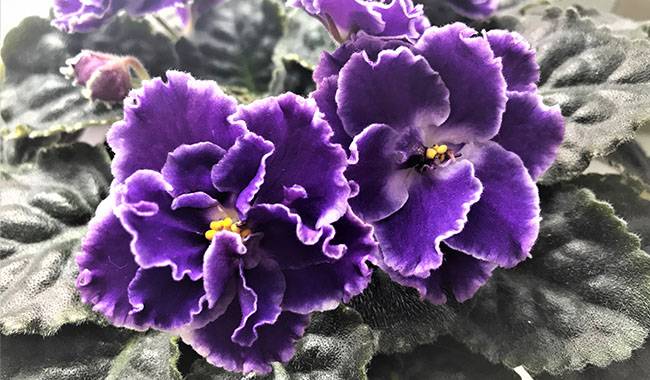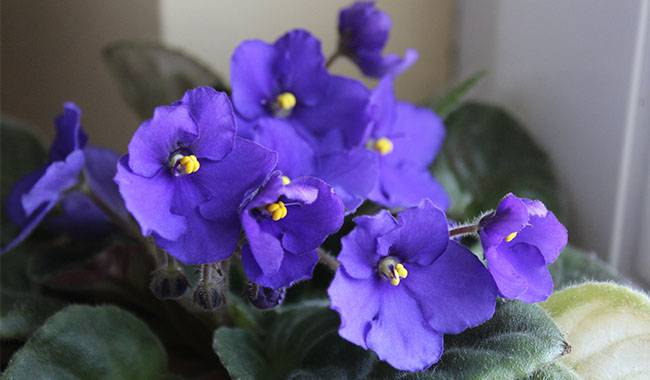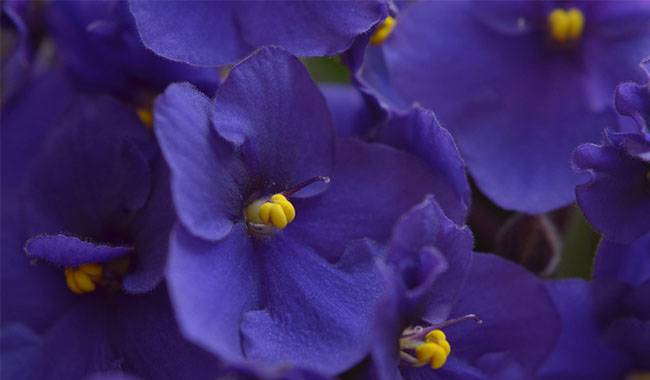
African violets (Saintpaulia) are making a comeback in the fashion world and turning around the idea of cute little flowering African violets that can easily live on any windowsill. Trends in the African violets “market” in Europe indicate a rapidly growing interest in plants with unusual foliage. More and more admirers are attracted not by the unusual color of the flowers, but by the exotic mottled color of the leaves. The mottled African violets are indistinguishable from almost all other tree species. But the bright glittering spots on the leaves completely change their appearance. You will learn How to Grow and Care African Violets(Saintpaulia) at Home in the ThumbGarden article.
AFRICAN VIOLETS (SAINTPAULIA) PLANT DESCRIPTION
Often referred to as houseplants, African violets are the most prolific in terms of flowering and the dullest in terms of greenery. For some reason, all African violets are considered to have dark foliage, velvety leaves, and neat rosettes of broken flowers. However, if you look closely not only at the flowering period but also at the greenery, you will see that the leaves of each variety are actually quite special.
Mostly round or oval, almost heart-shaped or narrow, with a broad base or narrow petiole, raised or almost pendulous, small, medium, and large, with margins of varying degrees of serration and varying shades of green, their curling effect also varies.
All Saintpaulia is individual and distinct. However, the “special leaves” of African violets are usually planted with ruffled edges (beautiful wavy cultivars), or new varieties of variegated African violets.
Unlike the extravagant collector African violets, which do not flower much and are grown only for their foliage, variegated African violets are mature, familiar African violets with a choice of luxurious flowers and variegated foliage.
LEAF DISCOLORATION – A UNIQUE VARIATION OF AFRICAN VIOLETS

Periphytic skeletonization is an atypical phenomenon for African violets, but it is not exactly an achievement of science either. It is a natural genetic mutation that reduces the amount of chlorophyll in individual leaf zone cells and actually breaks the typical metabolic changes of African violets.
The possibility of producing variegated African violets was discovered through a surprisingly unexpected mutation in one of the largest collections of African violets in the United States. Natural mutations are still the main tool for the production of these unique variegated African violets today. And the selection that enhances and improves the variegation in the offspring produces different variegation in the variegation.
The variegation of African violets is not a constant. Under other conditions, the best varieties may lose all their light and colored areas or, on the contrary, increase their area. The dependence on the quality of care and the stability of conditions are factors that determine the appearance of such mutations on the leaves of the plant.
The attraction of mottled African violets is that, unlike many other plants, each mutation is completely unique. In fact, the discoloration is unique to each plant. Their leaves can be colored from the edges and petioles, changing patterns throughout the aging process, providing different pattern variations on each leaf, and not repeating exactly once.
VARIED AFRICAN VIOLETS WITH VARIOUS FEATURES
All Variegated African violets are divided into groups based on the way the pattern appears not only on individual leaves but also on the entire rosette.
- Variegated varieties (trade name: Lillian Jared) with Variegated-like or marbled spots in the center or at the base of the leaves.
- Marbled varieties (trade name: Tommie Lou) are neat and beautiful African violets with light-colored margins that appear blurred at the edges of the leaves, but do not produce a plain effect.
- The Crown variety (trade name: Champion), with spots that diminish from the center of the rosette toward the edge and sometimes almost disappear on the lowest leaves, always appears differently on each leaf-from dusty, tiny spots to large ones, from rare spots to spots that cover the entire leaf disc almost evenly or cover it completely.
- A chimeric mutation is the appearance of a large green spot of a different color on a leaf, usually in the center of the leaf.
- Spontaneous mutations that occur in varieties without previously characteristic heterochromatic coloration.
Mutations in asexual reproduction are fully retained in variegated African violets, but there is a secret: the cleaner the leaves used for cuttings, the stronger the pattern on the offspring and the stronger the plant itself.
But new bushes are not easy to obtain: due to the mutation, the small, almost white rosettes that form on older leaves during rooting become more brittle and weaker than the traditional African violets. They can be separated from cuttings only when they grow well and the young rosettes appear dark green.
“SOME THINGS” THAT ARE IMPORTANT FOR MOTLEY AFRICAN VIOLETS

The discoloration of African violets does not only mean a change in decoration: the area available for photosynthesis on the leaves of African violets is also reduced. And the larger the surface area covered by the mottled area, the more dependent the plant is on light quality and care.
In general, the cultivation of variegated African violets is no different from the cultivation of all other African violets. However, if you want to keep your plants healthy and …… variegated, there are a few things to keep in mind. After all, this mutation can quickly disappear in an unsuitable environment.
The first thing you should do to ensure a mottled pattern is to check all the information about your plants when you buy them. At home, the variegated African violets should be recreated in the environment where they once grew, otherwise the pattern may disappear. Otherwise, just a few details need to be taken care of.
- Lighting is crucial for plants. Variegated African violets will not adapt as easily to change. Only good diffuse lighting and 12 hours of sunlight will ensure that variegated African violets show the full leaf pattern.
- The temperature requirements of mottled African violets differ only in one parameter: the maximum value. For centifolia with mottled leaves, high temperatures are not a problem, they prefer to stay indoors at temperatures not exceeding 68 °F (20 °C).
- One more thing to consider: water quality. Mistakes and watering with non-soft water will not be tolerated by moles.
- When fertilizing, do not use any fertilizer for African violets, but only fertilizers with less nitrogen than potassium and phosphorus.
THE BEST AFRICAN VIOLETS SPECIES
The first variant of the mutation was not introduced until 1959, two years after the mutation was discovered and tested on the offspring. For a long time, the white leaf margin was considered exceptional and for almost half a century only the very first variegated variety, the name of all the varieties with borders, Tommie Lou, could be found on the shelves.
But in the new millennium, the trend quickly changed, and the fashion for all things exotic and unusual also touched the lovely Sempora crumbs. In our country, in Europe, and in various countries, dozens of interesting varieties of mottled flowers have been actively cultivated.
The best varieties of speckled African violets rightfully top the list.
The crown varietal ‘Private Dancer’ has gray leaves with light pink spots that almost completely cover the center of the rosette and purple flowers with dense purple fringes.
The crown variety ‘Rob’s Scrumptious’ has watercolor pink to cream and medium green shades on the leaves, and candy pink flowers with white edges.
Variegated variety ‘Crabapple’ is a slow-growing variety with five to six shades of green that flow from the brown edges to the white centers of the leaves, contrasting with the dazzling bright pink terry flowers.
A Variegated variety, ‘Witch Doctor’, has dark green leaves with huge indentations on the edges, decorated with cream ornaments and fuchsia terry flowers.
The fringed variety ‘Alamo Gold Fever’ has a spreading striped wavy light border, white on the older leaves, and irregular red in the center of the rosette, which blends with the creamy white flowers.
A bordered variety, ‘Powwow’, has dark red single flowers and smooth oval emerald leaves decorated with a powdered border, thicker at the base of the leaves and thinner on the older leaves, covering almost the entire leaf disc except for the rest of the ‘feathers’.
The bordered variety ‘Buckeye Boysenberry’ is a large-flowered lavender variety with wavy petals and leaves decorated with a mottled light pink border.
One of the darkest foliage varieties, ‘Rob’s Outer Orbit’, has a creamy white ‘striped’ border that is particularly bright on the young leaves, and ultramarine flowers that are occasionally covered with light pink spots.
A nested ‘Lucky Penny’ variety with olive-green feathery spots on pale white foliage and distinctive faded lavender flowers that retain a deep purple blur in the center of the petals.
Many of the plants in the show remain nameless, if not randomly mutated. But this does not detract in any way from their beauty.







